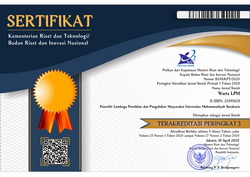Peningkatan Nilai Kopi Bajing Melalui Pelatihan Desain Kemasan di Pamanjur, Desa Girimoyo, Malang
DOI:
https://doi.org/10.23917/warta.v26i4.2082Keywords:
Desain Kemasan, Kopi Bajing, Nilai ProdukAbstract
Indonesia is on the path of the Bean Belt, which is an area suitable for the development of coffee trees. This makes Indonesia the fourth largest coffee producing country in the world with a production value of up to 12 million 60-kilo sacks by the end of 2020. Malang Regency, East Java, is one of the largest coffee bean producing regions in Indonesia. Squirrel coffee is a variant of coffee that comes from the rest of the coffee cherries consumed by squirrels. This process provides a distinctive taste and aroma for coffee lovers. The uniqueness of Bajing coffee has not been exploited by coffee farmers and Pamanjur. Even consumers are more likely to choose Arabica coffee than squirrel coffee, because they feel that the taste does not have a significant difference. As a result, the price of squirrel coffee is still unable to reach its full potential. The UMM Service Team assisted Girimoyo and Pamanjur Villages to Compile Product Value and packaging to increase the selling value of Bajing Coffee. Several steps were taken by the team to develop a program to strengthen the value of coffee squirrels in Girimoyo Village, including: holding a meeting with the owner of Pamanjur to obtain initial data, then the team tried to understand the flavor profile of coffee squirrels by conducting a taste test, then developing a program to strengthen the value of coffee squirrels through design. packaging, by changing the name of Bajing coffee to Belka coffee. The term "Belka" comes from the Russian language which is the name for the animal "Squirrel". After the concept matured, the team worked on a prototype of the Bajing coffee packaging. The final stage is the finalization and printing process carried out by Pamanjur. In conclusion, by taking advantage of the unique characteristics of Kopi Bajing and implementing an effective packaging design, Girimoyo Village can maximize the market potential of its specialty coffee.
References
Bakshi, S., Choudhary, H., & Badal, P. S. (2019). A Multistage Sampling Case Study in India of Food Packaging on Buyers ’ Behavior. Asian Journal of Agricultural Extension, Economics, & Sociology, 31(1), 1–7. https://doi.org/10.9734/AJAEES/2019/v31i130124
BPS. (2019). Luas dan Produksi Kopi Robusta Rakyat Menurut Kecamatan di Kabupaten Malang, 2016-2018. 2019. https://malangkab.bps.go.id/statictable/2016/09/06/552/luas-dan-produksi-kopi-robusta-rakyat-menurut-kecamatan-di-kabupaten-malang-2016-2018.html
Chandon, P., & Wansink, B. (2011). Is Food Marketing Making us Fat? A Multidisciplinary Review Does food marketing need to make us fat ? A review and solutions. Nutrition Reviews, 70(10), 571–593. https://doi.org/10.1111/j.1753-4887.2012.00518.x
Desmukh, A. (2021). The World’s Top Coffee Producing Countries. https://www.visualcapitalist.com/worlds-top-coffee-producing-countries/
Fenko, A., Lotterman, H., & Galetzka, M. (2016). What’s in a Name? The Effects of Sound Symbolism and Package Shape on Consumer Responses to Food Products. Food Quality and Preference. https://doi.org/10.1016/j.foodqual.2016.02.021
Gao, J., & Astillero, M. R. (2022). Product Packaging Design as the Basis of Product Purchase Decision. Indonesian Interdisciplinary Journal of Sharia Economics (IIJSE), 5(2), 516–530.
Harith, Z. T., Ting, C. H., & Zakaria, N. N. A. (2014). Coffee Packaging: Consumer Perception on Appearance, Branding, and pricing. International Food Research Journal, 21(3), 849–853.
Heatherly, M., Dein, M., Munafo, J. P., & Luckett, C. R. (2019). Crossmodal Correspondence between Color, Shapes, and Wine Odors. Food Quality and Preference, 71(June 2018), 395–405. https://doi.org/10.1016/j.foodqual.2018.08.019
Huang, L., & Lu, J. (2019). The Impact of Package Color and the Nutrition Content Labels on the Perception of Food Healthiness and Purchase Intention. Journal of Food Products Marketing, 22(July), 191–218. https://doi.org/10.1080/10454446.2014.1000434
Kapoor, S., & Kumar, N. (2019). Does Packaging Influence Purchase Decision of Food Products? A Study of Young Consumers of India. Academy of Marketing Studies Journal, 23(3), 1–16. https://doi.org/1528-2678-23-3-219
Mittal, S. (2020). “The Full Package”: Student-Centered, Peer Reviewed Packaging Design Activity. Journal of Higher Education Theory and Practice, 20(10), 91–99.
Petljak, K., Naletina, D., & Bilogrević, K. (2019). Considering Ecoligically Sustainable Packaging During Decision-Making while Buying Food Products. Economics of Agriculture, 1, 107–126. https://doi.org/10.5937/ekoPolj1901107P
Piqueras-fiszman, B., & Spence, C. (2014). Sensory and Hedonic Expectations Based on Food Product-Extrinsic Cues: A Review of the Empirical Evidence and Theoretical Accounts. Food Quality and Preference. https://doi.org/10.1016/j.foodqual.2014.09.013
Ridder, M. (2022). Coffee Export Volumes Worldwide in January 2022, by Leading Countries (in 1,000 60-kilo Sacks). https://www.statista.com/statistics/268135/ranking-of-coffee-exporting-countries/#:~:text=In January 2022%2C Brazil exported,60-kilo sacks of coffee.&text=Coffee is the second largest,consumed in the global north.
Sousa, M. M. M. De, Carvalho, F. M., & Pereira, R. G. F. A. (2020a). Colour and Shape of Design Elements of the Packaging Labels Influence Consumer Expectations and Hedonic Judgments of Specialty Coffee. Food Quality and Preference, 83(June 2019), 103902. https://doi.org/10.1016/j.foodqual.2020.103902
Sousa, M. M. M. De, Carvalho, F. M., & Pereira, R. G. F. A. (2020b). Do Typefaces of Packaging Labels Influence Consumers ’ Perception of Specialty Coffee? A Preliminary Study. Journal of Sensory Studies, June. https://doi.org/10.1111/joss.12599
Underwood, R. L. (2015). The Communicative Power of Product Packaging: Creating Brand Identity via Lived and Mediated Experience. Journal of Marketing Theory and Practice, 11(1), 62–76. https://doi.org/10.1080/10696679.2003.11501933
Velasco, C., Hyndman, S., & Spence, C. (2017). The Role of Typeface Curvilinearity on Taste Expectations and Perception. International Journal of Gastronomy and Food Science, November, 1–12. https://doi.org/10.1016/j.ijgfs.2017.11.007
Vieira, K. C., Alcantara, V. íde C., do Prado, J. W., Pinto, C. L., & de Rezende, D. C. (2015). How Does Packaging Influence Consumer Behavior ? A Multidisciplinary How Does Packaging Influence Consumer Behavior ? A Multidisciplinary Bibliometric Study. International Business Research, 8 (5)(April), 66–80. https://doi.org/10.5539/ibr.v8n5p66
Wandosell, G., Parra-meroño, M. C., Alcayde, A., & Baños, R. (2021). Green Packaging from Consumer and Business Perspectives. Sustainability, 13, 1–19. https://doi.org/10.3390/su13031356
Wang, E. S. T. (2013). The Influence of Visual Packaging Design on Perceived Food Product Quality, Value, and Brand Preference. International Journal of Retail and Distribution Management, 41(10), 805–816. https://doi.org/10.1108/IJRDM-12-2012-0113
Wijaya, R. (2022). Wabup Didik Ingin Komoditas Kopi Kabupaten Malang Punya Standar. https://www.malangtimes.com/baca/78851/20220409/194600/wabup-didik-ingin-komoditas-kopi-kabupaten-malang-punya-standar
Downloads
Submitted
Accepted
Published
How to Cite
Issue
Section
License
Copyright (c) 2023 Warta LPM

This work is licensed under a Creative Commons Attribution 4.0 International License.















